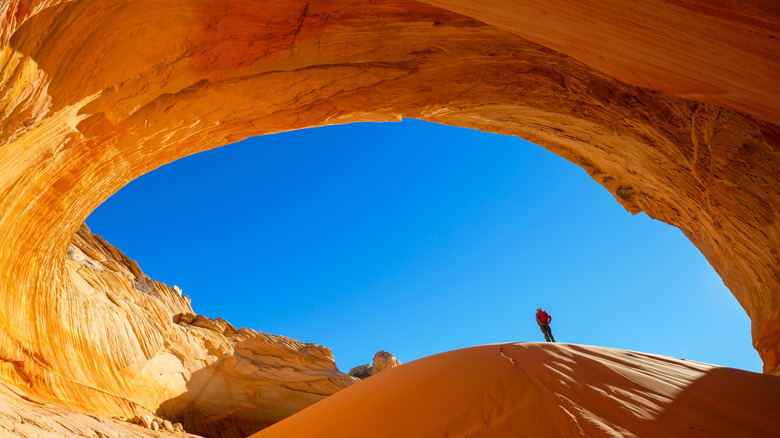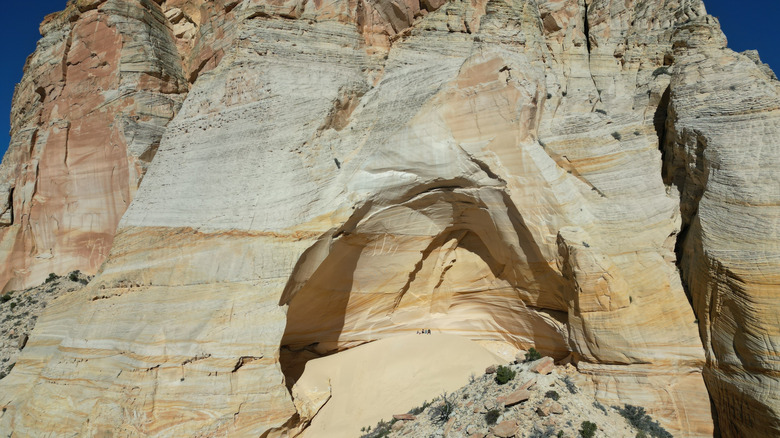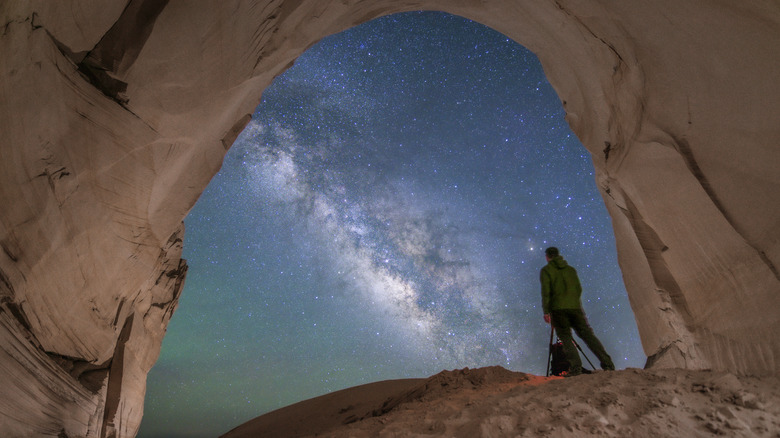One Of Utah's Most Sought-After Spots For Photographers Is A Uniquely Breathtaking Sandstone Mountain
How far would you go to capture the perfect picture? Would you traverse sandy paths, steep climbs, and sun-soaked dunes? If you're going to get shots of the Great Chamber at Cutler Point in Utah, the effort is worth every step. This incredible sandstone formation, located west of the Grand Staircase-Escalante National Monument, is a photographer's dream. Actually, the entire state of Utah is where you'll find some of the most striking desert landscapes. From the impressive and picturesque Capitol Reef National Park to the iconic views at Dead Horse Point State Park, the state is brimming with natural beauty. But the Great Chamber is something else entirely, a place that oozes a surreal sense of serenity. The fact that it's not that easy to reach makes it all the more one of a kind.
The easiest way to access the Great Chamber is by driving roughly 8 miles from Johnson Canyon Road or 9 miles from Kanab Canyon Road. After that, you'll need a four-wheel-drive vehicle to reach within a quarter-mile of the location. If you're coming from the east, start at the Crocodile Staging Area and follow BLM 100 and 103. Those coming from the west should take Kanab Canyon Road. Note that the road is paved for 1.3 miles before turning to gravel. A rough side road leads to BLM 103, where a shortcut forks off to the chamber — hilly but ATV-friendly. Even without a vehicle, you can still make the trip on foot, with a 4-mile hike across relatively flat ground.
Sand, wind, and time created this desert jewel
The Great Chamber is the result of wind erosion, which led to a breathtaking sandstone alcove that's more than 200 feet wide. Over time, natural forces carved out this massive opening in the rock face. This left a cavernous chamber with smooth, wave-like patterns. Subtle pinks, soft yellows, and off-white tones shimmer under the fiery sunlight while accentuating the chamber's unique textures. Thin rock layers slope gently at various angles, with their pastel hues giving the space an ethereal glow.
As for the giant sand dune at its base, it only adds another dimension to the extraordinary geological formation. Windblown sand piled up over the centuries and blanketed the structure. Back in the day, the sprawling dune stood much higher, but with avid hikers and sandboarders discovering this hidden gem, it has now reduced in size.
A white sand hill greets you at the entrance, where you'll stand before a silky sandstone arch. If this scene looks familiar, it's probably because you've seen photos of the Great Chamber's arch framing the clouds and Milky Way above — an unforgettable celestial spectacle contrasting the stark desert. Now that you know what kind of vistas to expect here, don't forget the essential items every aspiring photographer needs, like a solid camera case, to protect your equipment from all that sand.
Tips for visiting the Great Chamber
The best time to visit the Great Chamber is during the spring or fall, when temperatures are cooler and the trails aren't impacted by winter ice. If you're planning a midday adventure, be prepared — the sand can get scorching, so aim to start early. Make sure to have top-notch hiking gear with you, like sturdy boots, to properly navigate the terrain. And if you're alone, prioritize safety on your solo hike and have offline maps ready, especially trail maps.
Photographing the Great Chamber at Cutler Point is nearly foolproof. Whether you're using a digital camera, a GoPro, or your iPhone, this spot guarantees killer shots. The views are unreal, and with low foot traffic, you get uninterrupted moments to snap away. To do this place justice, you'll ideally have a wide-angle lens. A 12mm works great, but shooting at 16mm lets you capture the full scale of the alcove. Apple iPhones can handle this with a wide-lens attachment, but a professional camera gets you those sharp, detailed images.
When you're taking pictures, try using the sunburst effect and position the sun behind the cave wall for cool shadows. Take advantage of the patterns and textures in the stone, and keep an eye on the shifting sand dunes to add movement. Daylight is ideal here, especially around noon, but if you're into stargazing, the Milky Way is waiting for you at night. For expert-level results, check out our landscape photography tips for travelers.


